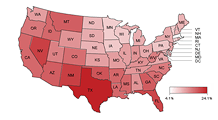Massachusetts leads health coverage - Census
Census Bureau reports that Massachusetts had the lowest 2008 rates of uninsured, while Texas had the highest.
NEW YORK (CNNMoney.com) -- A new study from the government Tuesday showed a wide disparity in health care coverage across the United States.
Using data from 2008, the survey from the Census Bureau showed that at 4.1%, Massachusetts had the lowest level of uninsured people of all 50 states and Washington D.C., while Texas had the highest with 24.1%.
Experts cite a number of factors for the wide range including programs already in place, whether or not illegal immigrants are counted, and wage differences.
Out of a population of 6.4 million people Massachusetts, 263,000 were uninsured, according to the Census Bureau. The state's low rate reflects in large part its mandate requiring most residents to purchase health coverage. The insurance must cover prescription drugs, emergency room visits, hospital services, mental health services and unlimited sick visits.
"Massachusetts is a microcosm of what the Democrats want to do on a national level," said Michael Cannon, director of health policy studies at the Cato Institute.
Cannon noted that the government's data may not be accurate, because he said the requirement provides residents with the incentive to lie to census-takers, "because admitting that you don't have insurance in Massachusetts is now illegal." For this reason, he believes that the percentage of the state's uninsured is actually higher.
But Merton Bernstein, founding member of the National Academy of Social Insurance and the Coles Professor of Law Emeritus at Washington University in St. Louis, said that Massachusetts had a low rate even before the mandate was enacted in 2006.
"The reason for that is that this is a very high wage area," he said. "Also this is a heavy population at colleges and university, which typically, although they may not pay so well, has a higher medical insurance than the general population."
Texas is the second-most populous state in the U.S., with 23.8 million residents, meaning that more than 5.7 million Texans are uninsured, according to the bureau's data.
Cannon said the large levels of the Texas' uninsured could reflect the large number of illegal immigrants in the state, which shares a border with Mexico. Joanna Turner, a statistician with the Census Bureau, said the bureau does not ask participants about their legal status, so those numbers are hard to pin down.
Bernstein said that Texas, unlike Massachusetts, "is just not into protecting the generality of its population."
He also found fault with the Massachusetts plan, because he said the coverage mandate could prompt some residents to opt for a low-premium plan with high deductibles, which would "discourage people from using it."
Florida, which has a large elderly population, also had a high percentage of uninsured, at 20.8%. Bernstein said this is because Florida is a "low wage state" where insurance is unavailable to many workers.
Overall, "there are a lot of pieces to the state variation," said Sharon Long, senior fellow at the Urban Institute's Health Policy Center. She said that Medicaid eligibility standards vary widely from state to state, with Massachusetts being more "generous" than most.
She said that areas with lots of educated people tend to have lower percentages of uninsured, since they tend to seek out jobs that offer insurance. Also, some areas might have corporate employers that offer insurance, while others do not.
"If you've got large manufacturing populations and large firms, they offer health insurance coverage," Long said. "If you have a small business-based economy, they're less likely to offer it. Retail firms are less likely to offer it."
Nationwide, the average percentage of the uninsured was 15.4% in 2008, or 46.3 million, according to Turner of the Census Bureau. The uninsured population rose from 45.7 million in 2007, but percentage was unchanged at 15.4%, she said. ![]()


